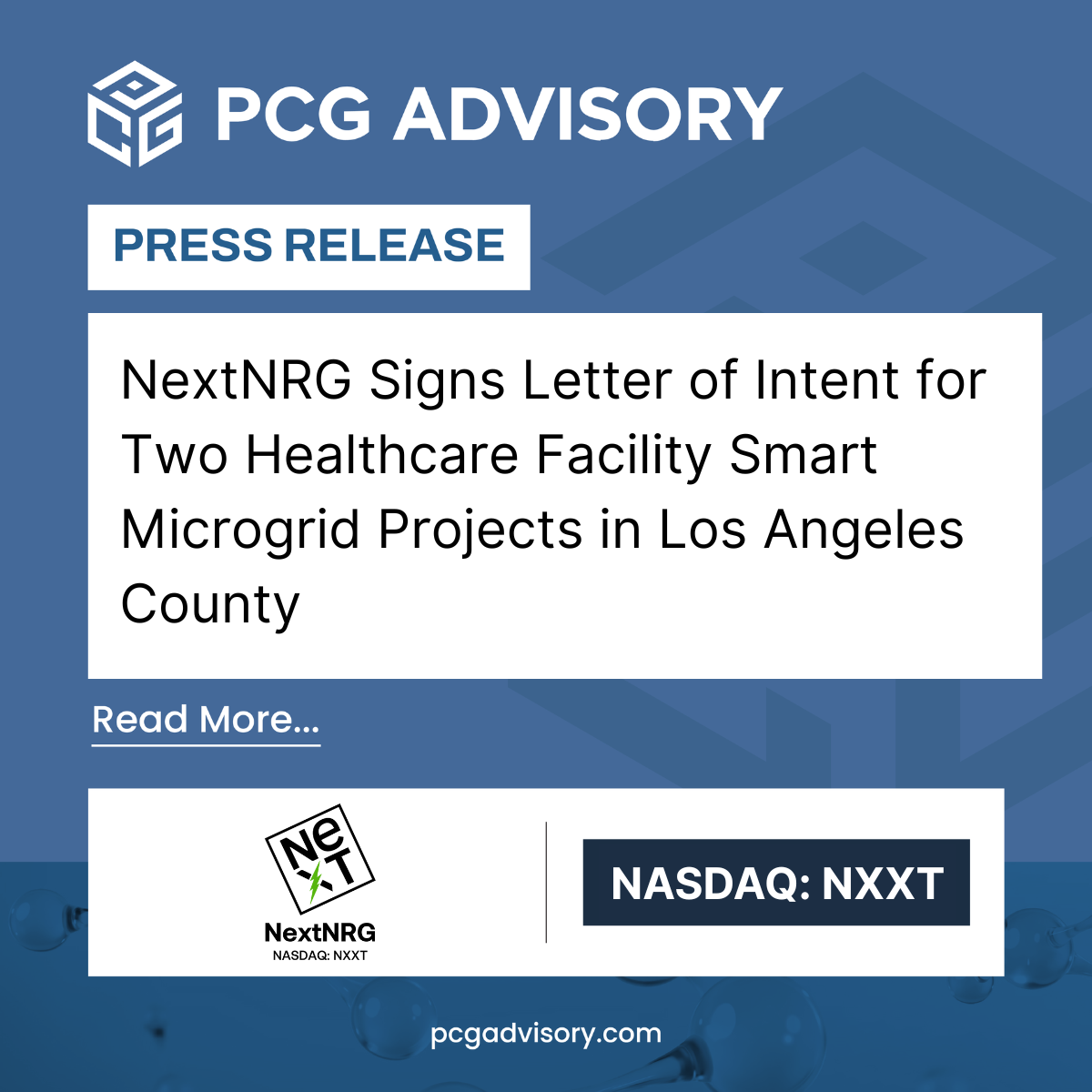NextNRG Signs Letter of Intent for Two Healthcare Facility Smart Microgrid Projects in Los Angeles County
5 months ago
Strategic expansion into essential healthcare sector demonstrates NextNRG'senergy-agnostic technology and own-and-operate model
Projects establish NextNRG as dedicated energy provider under long-term contracts to facilities requiring mandatory continuous power MIAMI, July 16, 2025 (GLOBE NEWSWIRE) -- NextNRG, Inc. (NASDAQ: NXXT), a pioneer in AI driven energy innovation transforming how energy is produced, managed, and delivered through its Next Utility Operating System®, smart microgrids, wireless EV charging, and mobile fuel delivery, today announced it has signed a letter of intent to develop critical energy infrastructure for two healthcare facilities operated by Sunnyside Nursing and Post-Acute Care (Sunnyside) and Topanga Terrace Rehabilitation & Subacute (Topanga) in Los Angeles, California. NextNRG will own and operate the complete smart microgrid systems and sell electricity directly to both facilities under separate 28-year Power Purchase Agreements (PPAs), establishing predictable long-term revenue streams in the essential healthcare sector where continuous, reliable power is not just preferred but mandatory. The PPA for the Sunnyside facility will generate revenue at $0.25per kWh with a 2% annual escalator, while the Topanga facility will generate revenue at $0.22 per kWh with a 2% annual escalator, providing NextNRG with contracted cash flows extending through 2053. NextNRG will design, build, own and operate comprehensive smart microgrid systems for each facility, then sell electricity from these NextNRG-owned grids to the healthcare facilities. The energy infrastructure will incorporate generation through solar and renewable sources, as well as battery storage for enhanced reliability. All components will be integrated into comprehensive smart microgrids powered by NextNRG's proprietary UOS (Utility Operating System) and SmartGrid technology. Each system will feature up to 830 kWh DC of solar photovoltaic capacity and 2.2 MWh of battery energy storage with ground-mounted solar arrays. By combining batteries with generators, NextNRG will significantly reduce the risk of power outages while ensuring compliance with HCAI (Healthcare Access and Information) requirements. The healthcare facilities gain operational resilience and access to tax incentives, while NextNRG establishes a strategic foothold in the highly regulated and lucrative healthcare sector. "These projects represent our strategic entry into the healthcare market, where energy reliability is mandatory rather than optional," said Michael D. Farkas, Founder and CEO of NextNRG. "The 28-year contracted revenue from selling electricity generated by our owned infrastructure provides exceptional visibility and stability, while demonstrating our software's ability to manage and optimize power from any source. This energy-agnostic functionality positions us to capture significant opportunities across the healthcare sector, where facilities require uninterrupted power for life-safety systems and patient care." The projects showcase NextNRG's proprietary technology platform designed to optimize and manage diverse energy inputs through advanced artificial intelligence, including traditional grid power, renewable sources, solar, and emerging technologies. This energy-agnostic capability provides maximum flexibility for healthcare facilities while demonstrating NextNRG's ability to serve as a complete energy solution provider rather than just a renewable energy company. Healthcare facilities represent a particularly compelling market opportunity for NextNRG's own-and-operate model. Hospitals, nursing homes, and other healthcare facilities prioritize energy reliability and long-term cost predictability, making them ideal candidates for long-term PPA arrangements. The healthcare sector's essential nature and regulatory requirements create a stable customer base with predictable energy needs and willingness to pay for enhanced reliability. The addressable market for NextNRG's smart microgrid solutions in the healthcare sector is substantial, with 15,300 nursing homes and 32,231 assisted living facilities across the United States. These facilities are subject to stringent regulatory requirements mandating backup power systems to ensure continuous operation of life-safety equipment, HVAC systems, and critical care infrastructure. NextNRG's comprehensive smart microgrids provide a superior alternative to traditional diesel generators, offering cleaner, more reliable backup storage while meeting all applicable healthcare regulations and emergency preparedness standards. NextNRG’s TAM in healthcare microgrids is roughly $3.2 billion in annual revenue opportunity today, growing into the $7–8 billion range by the early 2030s, driven by resilient infrastructure needs, AI integration, and regulatory tailwinds. "The healthcare sector represents a massive market opportunity where our ownership model and technology create significant value," added Mr. Farkas. "These facilities cannot afford power interruptions, and our comprehensive smart microgrid solutions powered by machine learning provide the energy security they require while generating stable, long-term cash flows for NextNRGfrom our owned energy assets. We see substantial potential to replicate this ownership and energy sales model across thousands of healthcare facilities nationwide." These projects build on NextNRG's recent momentum, including its partnership with Hudson Sustainable Group, inclusion in the Russell 2000® and Russell 3000® indexes, and record-breaking revenue growth with preliminary May 2025revenue of $6.6 million representing 148% year-over-year growth. The healthcare market expansion complements NextNRG's established mobile fueling operations across six U.S. states with 144 active delivery trucks. The agreement advances NextNRG's strategy of deploying next-generation energy infrastructure through its integrated ecosystem of AI-optimized solutions, establishing the company as a leader in intelligent energy management and delivery across essential service sectors.About NextNRG, Inc. NextNRG Inc. (NextNRG) is Powering What's Next by implementing artificial intelligence (AI) and machine learning (ML) into renewable energy, next-generation energy infrastructure, battery storage, wireless electric vehicle (EV) charging and on-demand mobile fuel delivery to create an integrated ecosystem. At the core of NextNRG's strategy is its Next Utility Operating System®, which leverages AI and ML to help make existing utilities' energy management as efficient as possible; and the deployment of NextNRG smart microgrids, which utilize AI-driven energy management alongside solar power and battery storage to enhance energy efficiency, reduce costs and improve grid resiliency. These microgrids are designed to serve commercial properties, healthcare campuses, universities, parking garages, rural and tribal lands, recreational facilities, and government properties, expanding energy accessibility while supporting decarbonization initiatives. NextNRG continues to expand its growing fleet of fuel delivery trucks and national footprint, including the acquisition of Yoshi Mobility's fuel division and Shell Oil's trucks, further solidifying its position as a leader in the on-demand fueling industry. NextNRG is also integrating sustainable energy solutions into its mobile fueling operations. The company hopes to be an integral part of assisting its fleet customers in their transition to EV, providing fuel delivery while advancing efficient energy adoption. The transition process is expected to include the deployment of NextNRG's innovative wireless EV charging solutions. To find out more visit: www.nextnrg.com.
Forward-Looking Statements This press release includes forward-looking statements within the meaning of the Private Securities Litigation Reform Act of 1995. Any statement describing NextNRG's goals, expectations, financial or other projections, intentions, or beliefs is a forward-looking statement and should be considered an at-risk statement. Words such as "expect," "intends," "will," and similar expressions are intended to identify forward-looking statements. Such statements are subject to certain risks and uncertainties, including, but not limited to, those related to NextNRG's business and macroeconomic and geopolitical events. These and other risks are described in NextNRG's filings with the Securities and Exchange Commission from time to time. NextNRG's forward-looking statements involve assumptions that, if they never materialize or prove correct, could cause its results to differ materially from those expressed or implied by such forward-looking statements. Although NextNRG's forward-looking statements reflect the good faith judgment of its management, these statements are based only on facts and factors currently known by NextNRG. Except as required by law, NextNRG undertakes no obligation to update any forward-looking statements for any reason. As a result, you are cautioned not to rely on these forward-looking statements.
Investor Relations Contact NextNRG, Inc.Sharon CohenSCohen@nextnrg.com

 Source: NextNRG, Inc.
Source: NextNRG, Inc.
The views and opinions expressed herein are the views and opinions of the author and do not necessarily reflect those of Nasdaq, Inc.

